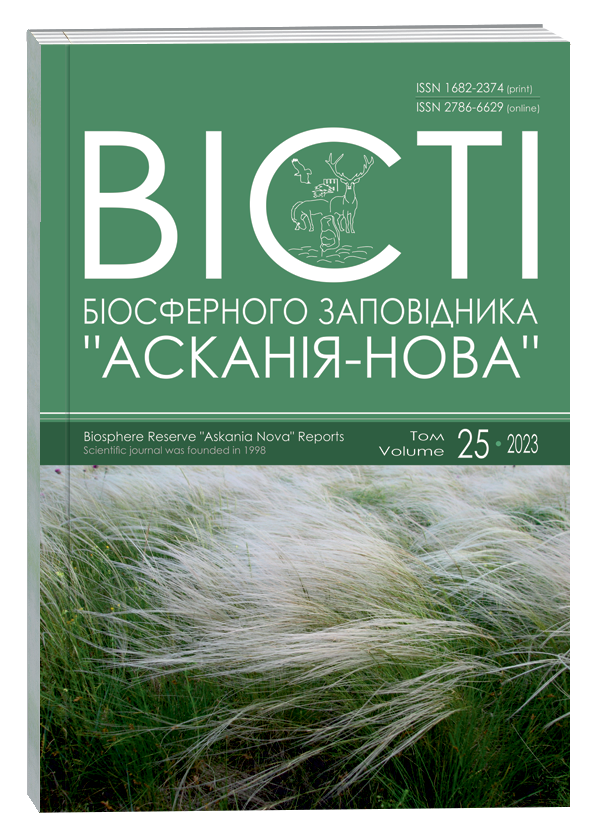BREEDING OF NILGAI BOSELAPHUS TRAGOCAMELUS IN THE ZOO "ASKANIA NOVA"
DOI:
https://doi.org/10.53904/1682-2374/2023-25/23Keywords:
Зоопарк "Асканія-Нова", нільгау, копитні, розведення, розмноженняAbstract
The results of research of breeding nilgai at the zoo "Askania Nova", are presented identifying three periods. Three periods of breeding are distinguished, and the characteris-tics of the imported antelopes are given. The dynamics of the number of animals, their elimination and births during the second and third periods of breeding (1948–2023) is presented. The conditions of keeping and reasons for the formation of nilgai groups are described. The peculiarities of repro-duction of this exotic antelope species in the south of Ukraine are given. The seasonality of breeding was observed in nilgai at the zoo "Askania Nova", although females are capable of giving birth throughout the year. The vast majority of nilgai calves were born from January to May, with a peak in February–April. The sex ratio (males : females) in newborns was 1.14 : 1. The survival rate of young animals at the zoo "Askania Nova" from birth to 6 months of age was 57.7%, and up to 12 months of age – 51.3%. Pregnancy lasted 243.8±0.57 days. The fertility of female nilgai at the zoo "Askania Nova" averaged 80.1%. Females gave birth to calves up to 13–14 years of age. Indicators of appearance and weight in adult animals were within the normal range for this species. Thus, the withers height of males and females was 131.0±1.0 and 122.3±1.1 cm, the oblique body length was 130.0±1.5 and 144.7±2.1 cm, the chest girth was 158.8±1.0 and 144.7±2.1 cm, the chest depth was 61,2±0,7 and 55,5±0,8 cm, respectively. The ethological features of nilgai in captivity are character-ised. The results of multispecies keeping of nilgai with representatives of the families Equidae, Cer-vidae, and Bovidae are described. During the breeding season, it is desirable to keep antelopes sepa-rately from the Equidae. It is acceptable to keep them together in large enclosures with dense vegeta-tion. Recommendations for improvement of nilgai keeping at the zoo "Askania Nova" are presented.
References
Звіт про науково-дослідну роботу "Вивчити основні біологічні особливості штучно створених популяцій та угруповань диких тварин при напіввільному утриманні на півдні України". № держреєстрації 0106U002554. Асканія-Нова, 2010. 247 с.
Зоопарк "Аскания-Нова" / Салганский А. А., Слесь И. С., Треус В. Д., Успенский Г. А. Киев : Госсельхозиздат УССР, 1963. 305 с.
Стекленев Е. П. Физиологические особенности размножения антилопы нильгау (Boselaphus tragocarnelus Pall.). Научные труды НИИЖ "Аскания-Нова". 1969. Т. 14, Ч. 2. С. 20–33.
Треус М. Ю. Особенности выборочного поедания растений антилопами (Antilopinae) в заповеднике "Аскания-Нова". Вісті Біосферного заповідника "Асканія-Нова". 2003. Т. 5. С. 188–194.
Asdell S.A. Patterns of Mammalian Reproduction. Ithaca : Cornell Univ. Press, 1946. 670 p.
Bayani Abhijeet, Watve Milind. Differences in behaviour of the nilgai (Boselaphus tragocamelus) during foraging in forest versus in agricultural land. Journal of Tropical Ecology. 2016. Vol. 32, Issue 6. Р. 469–481.
Berwick S.H. The community of wild ruminants in the Gir forest ecosystems, India. Ph.D Dissertation. Yale University, New Haven, 1974. 266 p.
Berwick S.H., Jordan P.A. First report of the Yale-Bombay Natural History Society studies of wild ungulates at the Gir Forest, Gujarat, India. J. Bombay Nat. Hist. Soc. 1971. Vol. 68. Р. 412–423.
Brander A. A. D. Wild animals in central India. London : Edward Arnold and Company, 1923. 296 p.
Cárdenas-Canales E. M., Ortega-Santos, J. A., Campbell T. A., García-Vázquez Z., Cantú-Covarrublas A., Figueroa-Millán J. V., DeYoung R. W., Hewitt D. G., Bryant F. C. Nilgai Antelope in Northern Mexico as a Possible Carrier for Cattle Fever Ticks and Babesia bovis and Babesia bigemina. Journal of Wildlife Diseases. 2011. Vol. 47(3). Р. 777–779.
Dharmakumarsinhji K.S. A field guide to big game census in India. Indian Board for Wildlife. New Delhi, 1959. Vol. 2. Р. 62–66.
Dinerstein E. An ecological survey of the Royal Karnali-Bardia Wildlife Reserve, Nepal. Part-III. Ungulate populations. Biol. Conserv. 1980. Vol. 16. Р. 5–38.
Haque N. Study on the ecology of wild ungulates of Keoladeo National Park, Bharatpur. Ph.D. Thesis. Centre for Wildlife and Ornithology, Aligarh Muslim University, Aligarh, 1990. 308 p.
IUCN SSC Antelope Specialist Group. Boselaphus tragocamelus. The IUCN Red List of Threatened Species 2016: e.T2893A115064758. http://dx.doi.org/10.2305/IUCN.UK.20163.RLTS.T2893A50182076.en.
Jarvis C. (Ed.) Species of wild animals bred in captivity during 1966. Int. Zoo Yearbook. 1968. Vol. 8. Р. 288–316.
Khan J.A., Chellam R., Johnsingh A.J.T. Group size and age-sex composition of three major ungulate species in Gir Lion Sanctuary, Gujarat, India. J. Bombay Nat. Hist. Soc. 1995. Vol. 92. Р. 295–302.
Lacey M. A note on breeding the nilgai Boselaphus tragocamelus at Stanley Zoo. Int. Zoo Yearbook. 1969. Vol. 9. Р. 115.
Leslie D. M. Boselaphus tragocamelus (Artiodactyla: Bovidae). Mammalian species. 2008. Vol. 813. P. 1–16.
Lochmiller R. L., Sheffield W. J. Reproductive traits of male nilgai antelope in Texas. Southwestern Naturalist. 1989. Vol. 34. Р. 276–278.
Lucas J. (Ed.) Species of wild animals bred in captivity during 1968. Int. Zoo Yearbook. 1970. Vol. 10. Р. 249–280.
Mirza Z. B., Khan M. A. Study of distribution, habitat and food of nilgai (Boselaphus tragocamelus in Punjab). Pak. J. Zool. 1975. Vol. 7. Р. 209–214.
Picquet Tianna. Effects of Invasive Nilgai Antelope (Boselaphus tragocamelus ) Browsing on Black Mangrove (Avicennia germinans) in South Texas: A Study on Microenvironmental, Physiological, Structural, and Reproductive Parameters. Theses and Dissertations. The University of Texas Rio Grande Valley, 2018. 339 р.
Prater S. H. The Wild Animals of the Indian Empire. J. Bombay Nat. Hist. Soc. 1934. Vol. 37. Р. 76–79.
Prater S. H. The Book of Indian Animals. Bombay : Bombay Natural History Society, 1971. 348 р.
Rahmani A. R. India. Antelopes / D. P. Mallon, S. C. Kingswood (eds). IUCN, Gland, Switzerland, 2001. Part 4: North Africa, the Middle East, and Asia. Global Survey and Reional Action Plans. Р. 178–187.
Sale J. B., Franzmann A. W., Bhattacharjee K. K., Choudhury S. Immobilization and translocation of nilgai in India using carfentanil. J. Bombay Nat. Hist. Soc. 1988. Vol. 85. 281–287 p.
Sankar K. The ecology of three large sympatric herbivores (chital, sambar, nilgai) with special reference to reserve management in Sariska Tiger Reserve, Rajasthan. Ph.D. Thesis. Univ. of Rajasthan, Jaipur, 1994.
Sankar K., Johnsingh A. J. T., Acharya B. Blue bull or nilgai (Boselaphus tragocamelus Pallas, 1766) of India. In Ungulates of India / Sankar K., Goyal S.P. (Eds.). ENVIS Bulletin: Wildlife and Protected Areas. Wildlife Institute of India, Deheradun, India. 2004. Vol. 7, No. 1. P. 29–40.
Schaller G. B. The Deer and the Tiger. Univ. of Chicago Press, Chicago, 1967. 370 p.
Schaller G. B., Spillett J. J. The status of the big game species in the Keoladeo Ghana Sanctuary, Rajasthan. The Cheetal. 1966. Vol. 8(2). Р. 12–16.
Sheffield W. J., Fall B. A., Brown B. A. The Nilgai Antelope. The Caesar Kleberg Program in Wildlife Ecology and Department of Wildlife and Fisheries Sciences. The Texas A&M Univ., 1983. 100 p.
The fauna of British India, including Ceylon and Burma / Edited by W. T. Blanford. Part 1. Mammalia. London : Taylor and Francis, 1888. 418 p.







